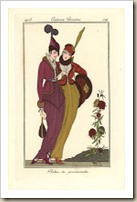
Over the centuries Paris has established itself as the location of the finest fashion houses. Haute couture has been appreciated worldwide, and talented artists were employed in France to introduce couturiers' fashion designs to the public. The Musée des Artes Decoratifs at the Louvre in Paris displays original illustrations by eminent fashion artists as well as fashions from previous eras.
In the late 19th and early 20th centuries, only the privileged could afford a subscription to an exclusive fashion magazine. The magazines were coveted, and their beautiful hand-coloured pochoir illustrations were framed and hung on walls. Pochoir, the French word for stencil, has been used worldwide since the French perfected this method of illustrating fashion during this period.
 The first and rarest of the luxury periodicals that used the pochoir method of illustration was Journal des Dames et des Modes – Costumes Parisiens (Journal of Ladies and Style - Paris Fashion), published by Italian emigré Tom Antongini from June 1912 to August 1914 (the outbreak of World War I). A flamboyant fashion designer, Paul Poiret (1879-1944) coined the Costumes Parisiens title from a publication that used hand-coloured engraved fashion illustrations early in the 19th century.
The first and rarest of the luxury periodicals that used the pochoir method of illustration was Journal des Dames et des Modes – Costumes Parisiens (Journal of Ladies and Style - Paris Fashion), published by Italian emigré Tom Antongini from June 1912 to August 1914 (the outbreak of World War I). A flamboyant fashion designer, Paul Poiret (1879-1944) coined the Costumes Parisiens title from a publication that used hand-coloured engraved fashion illustrations early in the 19th century.
Poiret's Costumes Parisiens featured beautiful, individually hand-coloured pochoir fashion plates, and included fashion notes and short sections of poetry to add to the appeal of the publication. Around 180 different images were produced during the short duration of publication. Each finely drawn image required different stencils to be cut for the application of successive layers of gouache by hand to build up each subtly-coloured image.

Fashion artists included Umberto Brunelleschii and Leon Bakst (both of whom were also designers). Charming pochoir illustrations were also contributed by Armand Vallée, Roger Broders, Etienne Drian, Pierre Legrain, Gerda Wegener, and other fine fashion artists. Outstanding illustrations by George Barbier were, and still are, some of the most in demand. Barbier made his debut as a fashion designer during the few years this periodical was published. It is a shame that these wonderful little pochoir illustrations are rarely seen today.
Slightly larger, Gazette du Bon Ton. Arts-Modes et Frivolités was produced from 1913 to 1925. It included literary works, lifestyle advice, information on how and where the latest fashions should be worn, and once again, beautiful pochoir illustrations. Paul Poiret was among the major couturiers who signed contracts, so that their designs could be introduced to the public by this magazine.
 Journal des Dames et des Modes - Costumes Parisiens began the custom of presenting designers' fashions in appropriate settings. Each charming scene tells a story of elegant behaviour and a privileged lifestyle. These delightful fashion illustrations captured the spirit of the era when they were painted.
Journal des Dames et des Modes - Costumes Parisiens began the custom of presenting designers' fashions in appropriate settings. Each charming scene tells a story of elegant behaviour and a privileged lifestyle. These delightful fashion illustrations captured the spirit of the era when they were painted.
The delightful pochoir illustrations of Costumes Parisiens for Journal des Dames et des Modes are still treasured by people of all ages. Their charm brings enduring joy when framed and hung on the wall. View and purchase online 24/7 at http://www.antiqueprintclub.com/ or visit the Antique Print Clubhouse in Neranwood, above Springbrook Road, west of Mudgeeraba: Email sales@antiqueprintclub.com or phone Kathryn on 0412 442 283.